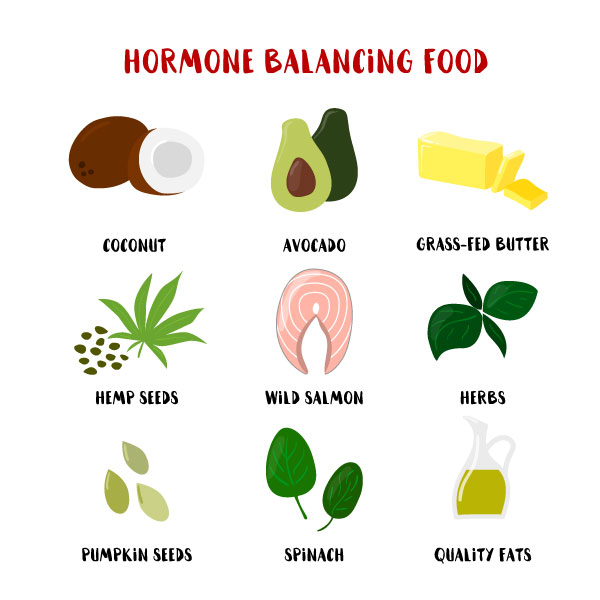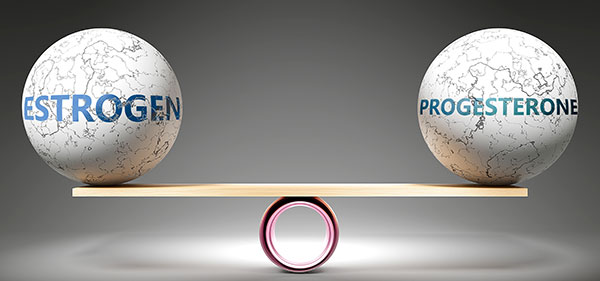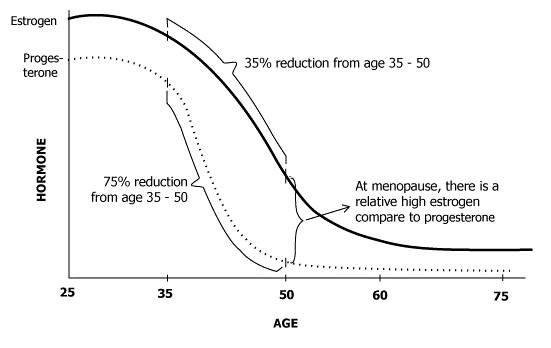Estrogen Dominance and Hormone Balancing
What You Need to Know
Lisa’s Story
Lisa is a hard-working woman who has dedicated her life to the service of others. As a speech therapist who owns her own practice, she is constantly busy improving her language therapy techniques while managing the finances of a small business. Ever since puberty, however, she has struggled with migraines. These persistent and enduring migraines always seem to be worse at the onset of her period and often leave her completely debilitated. She has taken the usual litany of migraine medicines, such as Imitrex and Topamex, but the medicine often left her feeling fatigued or dizzy with rebound headaches. Frustrated with the migraines that dictated Lisa’s ability to live her life, and the medications that left her with undesired side effects, Lisa began to research other, more holistic solutions to her migraines. Lisa’s ongoing battle with migraines had a direct and immediate impact on the life choices she made. She was ready to be the author of her own life and eradicate the migraine issue at its root.

The Importance of Hormone Balancing

How we feel and our quality of life are dependent upon the delicate balance of three essential functions:
- Reproductive Hormones — the body’s masters of ceremony
- Adrenal Glands — the body’s alarm system
- Thyroid Gland — the body’s furnace
These powerful components are intertwined, each dependent upon the others. When one is out of balance, it has a direct and tangible effect on the others. The net result is that your sense of well-being is diminished and your quality of life is negatively affected.
In this article, we address the relationship of two key reproductive hormones — progesterone and estrogen — and the influence of estrogen dominance on our overall health. We will explain how and why these hormones serve as our body’s “masters of ceremony.” In future articles, we will discuss the thyroid and adrenal glands, and their contribution to our health as a whole.
The Estrogen/Progesterone Relationship
Estrogen and progesterone play essential roles in the body, and understanding these roles is an important step in maintaining and renewing hormonal balance. In addition to the development of female characteristics at puberty and the beginning of the menstrual cycle, estrogen also affects skeletal growth, electrolyte balance, and the deposition of fat, protein, and skin.
While estrogen is a developmental catalyst and stimulant, progesterone is a multi-purpose hormonal building block. Progesterone is responsible for converting cholesterol into cortisol, DHEA (dehydroepiandrosterone), testosterone, and estrogen and for maintaining a healthy electrolyte balance and blood pressure level. Progesterone also prevents the uterine lining from shedding during pregnancy, making it crucial for fetus survival. One of progesterone’s most important roles, however, is preventing high levels of unopposed estrogen.

Both estrogen and progesterone are needed in the system — to work as members of a team as well as oppositional forces. It is important that the balance between them be maintained.
18 Estrogen Dominance Symptoms
High levels of estrogen become an issue when they are unopposed by adequate levels of progesterone. An excess of estrogen causes uncontrolled cell growth, leading to a variety of complications. Though there is usually less progesterone than estrogen in the body, serious problems can arise when the relationship becomes exceedingly off-balance. Excess estrogen is the only known cause of endometrial cancer, and it may also contribute to the following:
- Increased risk of breast cancer
- Loss of bone mass
- Increased risk of autoimmune disorders, such as lupus
- Fibrocystic breasts
- Uterine fibroids
- Depression and irritability
- PMS symptoms such as cramping and bloating
- Menopausal symptoms, such as hot flashes and night sweats
- Decreased sex drive
- Increased body hair and thinning of scalp hair
- Migraine headaches
- Impaired thyroid function, including Graves’ disease
- Increased body fat
- Increased blood clotting
- Impaired blood sugar control
- Endometriosis
- Polycystic Ovary Syndrome (PCOS)
- Low Thyroid Function

The first step for women in reclaiming their quality of life is to examine not just levels of estrogen and progesterone, but also the ratio between the two. Often, lab results will report that the levels of estrogen and progesterone are normal, but will fail to take into consideration their proportional relationship.
The estrogen/progesterone ratio is affected by a wide range of factors, including age, diet, steroids, thyroid, and other hormones. How does yours measure up?
How Does Estrogen Dominance Develop?

Estrogen dominance is common among women in industrialized nations and a normal part of the aging process. Although estrogen is almost always more prevalent than progesterone in the body, the imbalance is more pronounced between 35 and 50 years of age.
Beyond a woman’s age, there are three main sources of estrogen dominance:
- Pharmaceutical — synthetically produced hormones that are prescribed by a healthcare professional
- Xenoestrogens — chemically based estrogens found in a modernized environment
- Phytoestrogens — naturally occurring estrogen found in plants and plant derivatives
All three are capable of mimicking our body’s natural estrogen and can drastically alter hormonal balance.
Pharmaceutical
Prescriptions that address hormonal imbalances can increase estrogen dominance and lead to additional complications. Unfortunately, pharmaceutical companies will not advocate for a medicine they cannot patent, which is why synthetically produced hormones are prescribed more frequently than safer options, such as bio-identical hormones. Synthetic estrogen and progesterone are directly linked to estrogen dominance and it’s symptoms.
- Synthetically produced hormone replacement is extremely potent, initially eradicating symptoms of estrogen dominance but leaving the body with long-lasting negative effects. The strength of the synthetic estrogen confuses the body into believing it no longer needs to produce estrogen itself, paradoxically throwing off the estrogen/progesterone balance.
- Synthetically produced progesterone (progestin), like synthetically produced estrogen, inhibits a woman’s body from making its own progesterone, leading to detrimental health complications.
Xenoestrogens
There are more than 70,000 registered chemicals in the U.S. that have toxic hormonal effects. Xenoestrogens can be found in plastics, canned foods, yogurt containers, baby bottles, styrofoam, pesticides and herbicides, paints, lacquers and solvents, detergent, personal care products, artificial scents and air fresheners, perfumes, feminine hygiene products, fuels, industrial chemicals (cadmium, lead, mercury, PCBs, and dioxins), dairy and meat raised with rBST (recombinant bovine growth hormone), and even the synthetic hormones prescribed to combat estrogen dominance.
- Problematic Xenoestrogens — A Closer Look at BPA: One of the most potent xenoestrogens, BPA (bisphenol A), is commonly found in plastic bottles and can linings. While the FDA has been indicated that limited exposure to BPA is not harmful, recent studies reveal that actual exposure to this xenoestrogen is exponentially greater than the FDA concedes. The FDA has released a strong health advisory for the avoidance of BPA by expecting and nursing mothers, leading many to wonder if any exposure is safe for children or adults.
Phytoestrogens
Phytoestrogens are naturally produced and are generally weak in comparison to xenoestrogens or the body’s naturally occurring estrogen. They are found in soy (soybeans, soy milk, tofu, tempeh, textured vegetable protein, roasted soybeans, soy granules, soy protein powders, miso, edamames), the lignans in flaxseed products, red clover, black cohosh, chasteberry, and dong quai. The overall effect of plant-based estrogen is minimal in comparison to chemically based estrogen, but women with an estrogen dominance should nonetheless avoid eating foods containing phytoestrogens.
Estrogen Dominance Testing
Most medical professionals test only for estrogen and rarely do they assess progesterone levels and the relationship between the two hormones. Ignoring these important factors can leave women without real solutions. And with so many different testing options, it’s difficult to know which are the best.
Here is a look at two of the most common tests:
1. Blood Testing
Most estrogen and progesterone are protein-bound, with only 2-5% percent “free” in the body. The “free” estrogen and progesterone are what affect the body and its functions, while the protein-bound hormones are generally inactive. Unfortunately, standard blood tests measure the inactive protein-bound hormones .

2. Saliva Testing
Saliva testing measures hormones that are biologically active, or “fractionated.” Saliva tests are inexpensive, can be done at home, and consist of various samples taken at different times throughout one full day. Since the body’s hormone levels fluctuate during the day, this method provides a more accurate representation of the true estrogen/progesterone relationship. Additionally, saliva testing analyzes the levels of testosterone and the stress hormone cortisol, offering a more comprehensive view of overall hormonal health.
You can take control of the situation and regain the sense of well-being that you once enjoyed. With a thorough evaluation and consultation, appropriate health changes can be made to reclaim your quality of life. Each situation is different, and the approach will vary based on your specific needs. With assistance, you can rebalance your body and return to a better state of health.
How to Correct Hormonal Imbalances
How to Correct Hormonal Imbalances
Until recently, healthcare providers prescribed pharmaceutical hormones for menopausal symptoms or estrogen dominance. Many practitioners now, however, reject such treatment methods because studies show that synthetic hormones often compound a hormonal imbalance and lead to a higher incidence of breast cancer, heart disease, stroke, blood clots, and dementia. Additionally, this medicine also makes tumors more difficult to detect. Due to negative side effects and proof that synthetic hormones often increase estrogen dominance, many practitioners and women are turning to bio-identical hormone replacement, along with lifestyle and diet changes. It is crucial that every woman finds a health practitioner who understands how to incorporate a variety of treatments that work for her specific needs, such as bio-identical progesterone, nutrients, and DIM and Calcium D-glucarate.

- Bio-identical hormones are much safer and more sustainable than synthetically produced hormone supplements. Since the bio-identical hormones are natural and have not been chemically altered in a lab, they do not cause detrimental secondary health issues. The bio-identical progesterone and estrogen supplements can be sublingual or transdermal and have a number of benefits, such as symptom relief for migraine headaches, PMS, and menopause; improved sleep patterns; and possible protection against breast cancer and endometrial cancer. Sublingual supplements are more effective because they can be quickly and completely absorbed by the body, while transdermal creams often get trapped in fat cells beneath the skin.
- Bio-identical hormones are much safer and more sustainable than synthetically produced hormone supplements. Since the bio-identical hormones are natural and have not been chemically altered in a lab, they do not cause detrimental secondary health issues. The bio-identical progesterone and estrogen supplements can be sublingual or transdermal, and have a number of benefits such as symptom relief for migraine headaches, PMS and menopause, improved sleep patterns, and possible protection against breast cancer and endometrial cancer. Sublingual supplements are most effective since they can be quickly and completely absorbed by the body while transdermal creams often get trapped in fat cells beneath the skin.
- Bio-identical hormones are much safer and more sustainable than synthetically produced hormone supplements. Since the bio-identical hormones are natural and have not been chemically altered in a lab, they do not cause detrimental secondary health issues. The bio-identical progesterone and estrogen supplements can be sublingual or transdermal, and have a number of benefits such as symptom relief for migraine headaches, PMS and menopause, improved sleep patterns, and possible protection against breast cancer and endometrial cancer. Sublingual supplements are most effective since they can be quickly and completely absorbed by the body while transdermal creams often get trapped in fat cells beneath the skin.
Lisa’s Resolution

After consulting the appropriate healthcare provider, Lisa removed as many xenoestrogens and phytoestrogens from her home environment and diet as possible. She began taking bio-identical progesterone and nutrient supplements and quickly noted a drastic improvement in her overall health. She has been migraine-free ever since.
